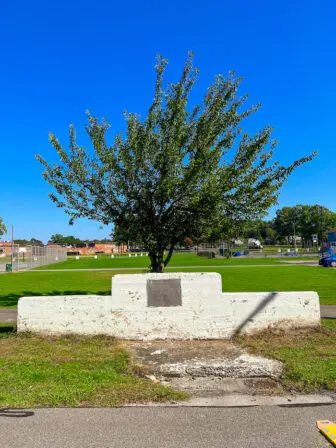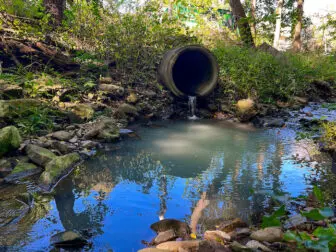Nine years ago, Jennifer Epstein was pushing her newborn son in a stroller through Memorial Park in Beacon when she found what looked like a gravestone. There wasn’t a body buried underneath. Instead, it was a body of water.
The white monument sports a plaque commemorating the Asylum Brook Project, in which the eponymous stream was buried in a 60-inch pipe in 1933, during the Depression. Epstein, a freshwater ecologist who was working at the time for Riverkeeper, had never heard of Asylum Brook. Standing in front of the plaque, she emailed the Beacon Historical Society.
It was the first step in a nine-year research project that Epstein undertook as a labor of love. (She and her family now live in Bolivia, where her husband, Adam Kendis, is director of college counseling at Santa Cruz Cooperative School.) Earlier this year, Epstein posted The Story of Asylum Brook at bit.ly/asylumbrook.

Asylum Brook got its name from the fact that its headwaters seemed to emerge near the Matteawan State Hospital, known for much of its existence as a facility for the “criminally insane.” Starting in 1912, inmates were assigned to bury the stream because prevailing wisdom considered wetlands to be incubators of disease. The state Assembly believed the work “would furnish a pleasant variety of labor without mental strain” for the prisoners.
Burying the brook made it stronger, intensifying its flow downstream. The City of Beacon was created in 1913 from the villages of Matteawan and Fishkill Landing, but at their borders on Main Street between Eliza and Chestnut it was constantly flooding, an ill omen. Residents spent two decades demanding action, interrupting City Council meetings and filing lawsuits.
That led to more pipe being laid (and memorialized) in 1933, but it wasn’t enough. As the hospital expanded, more land was paved and more wetlands were funneled through the pipes. The city finally found the money in the late 1950s to finish the job.
If you stand at the memorial marker and think you can hear the ghostly sounds of the brook, you’re not hallucinating. It still rushes underneath nearby storm drains and funnels through a 1959 pipe into Fishkill Creek just below the dam at the Roundhouse. There’s only one place that the brook still flows naturally: just behind the Madam Brett Homestead, on its way to the creek.
The saga of Asylum Brook is not unique. As cities expanded in the 19th and 20th centuries, many transformed ecosystems of streams and brooks into ecosystems of pipes. But streams are not fixed entities. Their paths change, their banks change, their height and depth change, even the types of vegetation that grow alongside them changes. Add climate change, population change and land-use change, and streams previously tamed will break free. “They’re dynamic,” said Epstein. “We’ve tried to make them static, and it’s not working anymore.”

Some cities have “daylighted” their hidden streams, such as what Yonkers did with the Saw Mill River. As the frequency of catastrophic flooding increases in New York City, some environmentalists are advocating the city daylight some of its many underground rivers, such as Tibbetts Brook in the Bronx, to ease the strain on the overburdened sewage system.
Burying Asylum Brook solved a host of problems, but daylighting it would involve, among other things, ripping up the baseball fields at Memorial Park where Epstein’s children played Little League. But with development projects being sought for the land where inmates once buried Asylum Brook, Epstein believes daylighting the brook at its source should be considered.
Thanks to heavy rains hitting the Hudson Valley with increasing frequency and intensity, freeing some of the brook could prevent flooding. “A lot of climate mitigation strategies have to do with restoring natural hydrological flows, and restoring the ability for water to seep into the ground, instead of being funneled quickly through pipes,” said Epstein.
She also thinks it’s worth looking deeper into Beacon’s hydrological history to see what other streams may be flowing underneath. During her research, older Beacon residents mentioned a pond near Willow and Elm streets that they used to boat and ice skate on; they also recalled catching frogs from its marshy surroundings.
Where did it go? Epstein hasn’t had a chance to find out, but as the mounting flooding disasters of the 21st century have been showing, nothing stays buried forever.


Hello I’m the little baby in the stroller and I would like to say that you should edit this article because only I play Little League. My brother, Samuel, plays T-Ball at Memorial Park. Also, you should write more about my mom’s children, Jesse and Sam.
This came up recently in the Beacon Planning Board for the subdivision of 44 Kent St. The city engineer forced the developer to relocate the proposed house and driveway so that the city could have future access if needed to the covered creek. I heard from someone who grew up on Verplanck that one of the houses used to flood often from the creek and the foundations had to be rebuilt because of the damage. You can see the pipes running in the storm drain in front of 155 Verplanck.